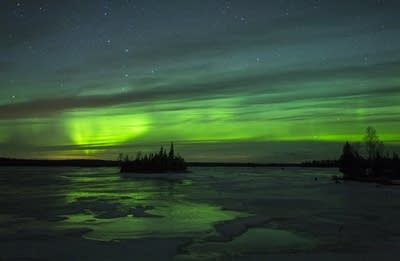6 tips for photographing the Northern Lights
Go Deeper.
Create an account or log in to save stories.
Like this?
Thanks for liking this story! We have added it to a list of your favorite stories.

Photographers of all abilities can learn how to capture auroras. Here are six tips and tricks to increase your success.
Choose a fast lens that is wide.
A lens with a fast aperture like 2.8 or even 1.4 is preferable. Last week's auroras stretched across the entire horizon and high into the sky. You'll need a wide lens to capture the entire scene. I like to go anywhere between 16mm and 24mm, but you can zoom in if you want to isolate elements of a scene such as a tree against the Northern Lights.
Turn Up Your Support
MPR News helps you turn down the noise and build shared understanding. Turn up your support for this public resource and keep trusted journalism accessible to all.
True focus might be the trickiest part for many people.
I like to use manual focus and set the focus ring on infinity, then take a test shot and use the viewfinder to zoom in on the stars to see whether they are in focus.
If not, adjust the ring a little more until the stars are in focus. You can also go out during the day and focus on an object in the distance, note where the focus point is and leave a mark on your lens for reference at night.
Don't be afraid to push the ISO high.
Digital cameras are really good today at producing high ISO images with little noise. Combine that reality with the abilities of programs like Lightroom and Photoshop to further reduce noise and you shouldn't have any issues. You really can go as high as 5,000 ISO without too much loss of quality. I typically shoot at 2,500 or 3,200 ISO.
A tripod is a must.
Most of your exposures are going to be on the order of seconds. Some might even be as long as 30 seconds. You will need a sturdy tripod to keep the camera still for the entire exposure.
Get away from city lights.
Light from street lamps, buildings, cars and other city sources will put a serious damper on your ability to capture Northern Lights. For a city like Duluth, I'd recommend getting 15 to 20 miles away. Boulder Lake and Island Lake are good options, but the farther you can go the better.
The Great Lakes Aurora Hunters group has a great interactive map with dozens of locations to capture the lights with notes about each place.
Experiment, experiment, experiment.
The best way to get great Northern Lights photography is to simply go out and shoot. Experiment with your settings, try new things, angles, focal lengths until you find something that works for you.






